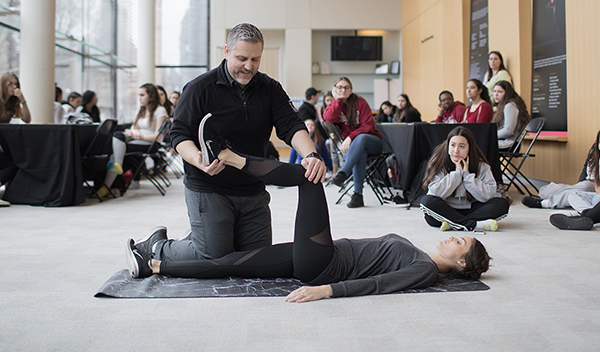Keeping Performance Ready
February 4, 2019

Q&A with Paul Papoutsakis, Company Athletic Therapist and Ginette Hamel, Company Physiotherapist
Describe your work at the National Ballet.
Paul: As Company Athletic Therapist, I am part of a larger wellness team of varied medical professionals but I am the only person who is full-time onsite. I find that I am often the ‘go to’ contact for the dancers. I can address any issues they have and liaise with our Director of Dancer Wellness to expedite the treatment they need.
Ginette: My job as Company Physiotherapist is to assess, treat and give exercises to help the dancers rehabilitate injuries that prevent them from dancing. My goal is to help the dancers continue to dance without pain, while keeping them safe from long-term injuries.
What does a typical day look like for you?
Paul: My day starts before the dancers are finished Company Class. In this quieter time, I look at any new medical reports and I set up appointments with various members of the wellness team if a dancer needs to have a follow up. I see dancers after class and help them prepare for their rehearsals for the day ahead. In these individual 15 or 30 minute appointments, I assess and treat injuries and create cross-training and conditioning programs that the dancers will do during their busy day. I stay onsite until the end of the rehearsal day or until the half hour call on performance days. It’s this non-stop activity that makes my job one of the best.
Ginette: While they are in rehearsal, I see dancers for 15 minute appointments during their lunch hour. This gives me enough time to deal with current problems through manual therapy, dry needling (a form of acupuncture) and taping, amongst other treatments. After their lunch break, the dancers get 30 minute appointments, which allows me to look deeper into the cause of their problems. When we move to the theatre, the schedule is more fluid and can involve visits to the rehearsal studio or dressing rooms.
Ginette, you work a lot with a variety of artists. Do you have to approach your work differently when treating ballet dancers?
I have the privilege to work with musicians as well as actors from stage, television and film. The biggest difference with dancers’ injuries is that the impact on their career is much bigger. Just like professional athletes, dancers only have a few years to rise to the top of their career and they have only a few years there. This means that we can’t waste any time and have to figure out the biomechanics of their problems quickly. The other major difference is that I get to see them in their place of work, making access to treatment faster. In working onsite, I am able to advocate for the dancers’ wellbeing and monitor how much they do in their return to work.
Paul, you also travel with the company while they go on tour. Why is it important that you do so and what unique challenges do you face while on tour?
Traveling presents unique challenges as I need to make sure I have local medical contacts to help us deal with non-orthopedic issues that may arise, as well as any emergencies. Dealing with orthopedic issues is the easy part. Waking up in a foreign country with an eye infection or stomach virus, which may require prescription medications or a specialist follow-up, pose difficulties that a local contact can help navigate. Today, however, we are connected globally and our wellness team is always available. I have used FaceTime and Skype to help assess dancers and get them the help they require. This familiarity and consistency in care is important for the dancers to have. Being with them on tour ensures that the health and wellness of our dancers is always being fully addressed.
Delve Even Deeper by Becoming a Donor >